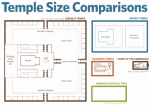Ezekiel 40-48 describes the future heavenly Jerusalem which comes down from heaven. The "temple" as used in Ezek 40-48 isn't a temple, the word used literally means "house." This isn't anything built by man. To prove I'm right, look at the size of this place. Its massive. The below depicts the size of this "temple" compared to the previous 2 literal temples:
View attachment 124494
There is one thing worth noting about the size of the Temple in Ezekiel.
42:15 Now when he had finished measuring the interior of the temple, he led me out by the gate which faces east and measured all around.
42:16 He measured the east side with the measuring stick as
875 feet by the measuring stick.
42:17 He measured the north side as
875 feet by the measuring stick.
42:18 He measured the south side as 875 feet by the measuring stick.
42:19 He turned to the west side and measured
875 feet by the measuring stick.
42:20 He measured it on all four sides. It had a wall around it,
875 feet long and 875 feet wide, to separate the holy and common places.
Literally, it reads "500 reeds." It's interesting here because everywhere else in Ezekiel's measurements he measures it in "cubits." Both a cubit and a reed are well known measurements in the ancient world. 1 Cubit = 1.5 ft. But 1 Babylonian Reed = 9.9 ft.
Most translators think Ezekiel meant to say the measurements of the outer walls were "500 cubits" which works out to about 875 ft. as is found in some translations. But when Ezekiel says the temple is "500 reeds" the literal measurement of a reed would mean his temple was about 5,000 ft by 5,000 ft!! Or very roughly, 1 mile by 1 mile wide!! It's basically as big as the old city itself.
So the interesting question is, is this a scribal mistake of later times? Did Ezekiel really write or intend "500 cubits" that was somehow later copied or understood as "500 reeds," or did Ezekiel intentionally write "500 reeds" and intend his temple to be roughly the size of the entire city?
I tend to think he intentionally wrote "500 reeds" and that his temple was as big as the city.


